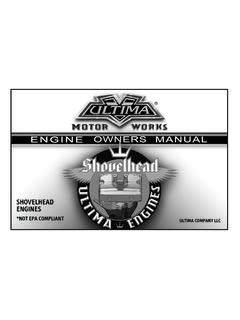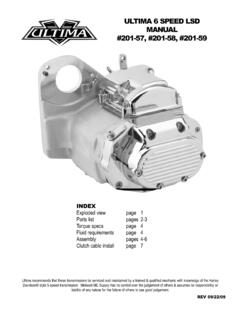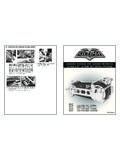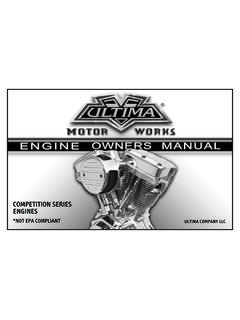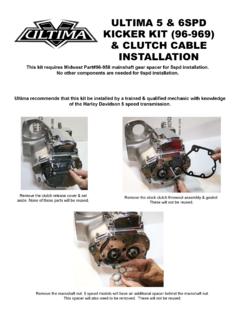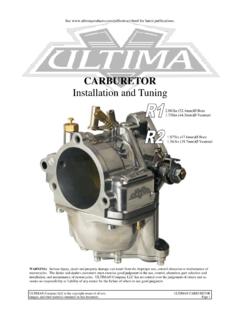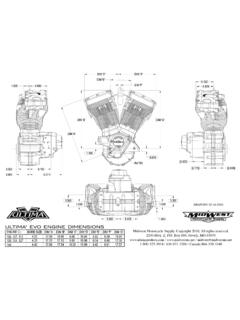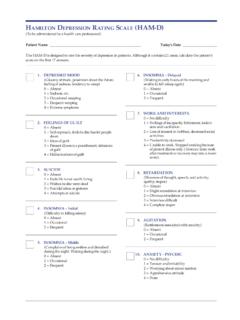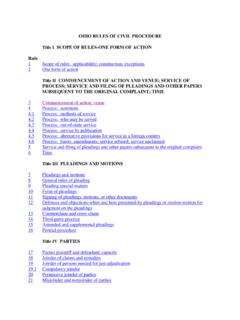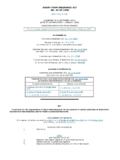Transcription of INSTALLATION INSTRUCTIONS FOR ELECTRONIC …
1 INSTALLATION INSTRUCTIONS FOR ELECTRONIC single FIRE IGNITIONPART NO. 53-50 INSTALLATION INSTRUCTIONS for street application using 1970 & later coils with 5 ohms of primary resistance. If installing in a raceapplication, you may use 3 ohm old the new advance assembly shaft lightly with oil. Put the magnetic rotor over the shaft and push it to connectwith the advance assembly weights. Make sure that the rotor rotates easily and the weights cycle back & to make sure the pin on the assembly seats in the slot for it on the engine. Install & tighten the bolt. Don t overtight-en, the rotor must rotate the standoffs to install the ignition with the plate aligned so the large power module is at either 12 o clock or 3 o clock.(this will depend on the model).
2 The exhaust pipes, put the ignition assembly cable out through the engine case hole. Attach the connection endsto the the jumper wire to connect the primary studs of the coils. One of these will also be the contact for the ignition switchwire (12V) and the other will be the contact for the ignition s Red Black wire attaches to the other end of the front cylinder s coil, across from the ignition switch wire. The White wireattaches to the other end of the rear cylinder s coil opposite the Red wire. Ensure all the connections are firmly ADJUSTMENT FOR single PLUG SET UPIf you re using dual plug set up, you might need different only need set the timing for the front cylinder as the firing angle of this ignition is factory pre-set to coordinate therear cylinder the OE shop manual for the engine s timing mark and use the flywheel s timing advance indicators.
3 Clockwiserotation of the ignition plate will advance the timing and the reverse will retard the TIMING out the crank case timing hole plug and substitute a see-thru acrylic timing plug such as our part No. 91-104whichfits all years H-D , including late models. Connect strobe timing light to the spark plug of the front maintaining 2000 rpm on the running engine, aim timing light into the inspection hole. Confirm where the frontcylinder timing is set at and rotate ignition plate to center the front cylinder timing mark in the view hole. Clockwise rota-tion of the ignition plate will advance the timing and the reverse will retard the the mark for the front cylinder is set at center, you can tighten up the ignition plate s standoffs, change out the acrylicplug for the case hole plug and reattach the TIMING attaching a 12V test light to the Black coil wire and grounding it to the engine case, manually rotate the engine untilthe front cylinder is on the compression stroke.
4 Take out the crank case timing hole on the ignition and hold the ignition rotor counterclockwise into advanced position with the weights against thestops. Then slowly rotate the engine forward until the test light brightens. Check in the timing hole to see that the frontcylinder s advance mark is centered. If it is, go on to Number 4 the front cylinder s advance mark isn t centered in the timing hole, turn off the ignition. Loosen the ignition plate sstandoffs and rotate the ignition plate clockwise to advance or counterclockwise to retard the timing. Once you get it to thecorrect position you should retighten the ignition plate standoffs then perform Number Two above again. Repeat NumberTwo and Number Three until you achieve the proper you make sure no wires are contacting the rotor, you can replace the crankcase timing hole plug and the side SYSTEM TESTING ON BACK OF SHEETFFOORRMM 223388BB IGNITION SYSTEM TESTING FOR PART NO.
5 53-50 VISUAL INSPECTIONC heck to see that the rotor isn t rubbing on the power modules on the ignition plate. Fully advance the rotor and it shouldsnap back to the original position. Do the two above inspections once when the motor is cold and then later when theengine is hot. After marking the timing on the case and the ignition plate, remove the ignition and make sure that theadvance isn t contacting the ignition plate. Check the cable for damage caused by pinching or heat. Make sure areas ofsplicing & crimping are firmly attached. See if the connections for the coil are clean & tight. You can install split lock wash-ers on the coil screws. Take off the spark plug wires and look for corrosion and cracked or chipped insulation.
6 Using anohmmeter, connect both ends of the wire and tweak and twist to check if the wiring is broken. Pull out the spark plugs andcheck for fouling. Clean them & reinstall unless too dirty, then just replace them with new THE VOLTAGET here should be a minimum of 3 ohms primary resistance of the engine coils - don t forget to take the resistance of themeter leads into consideration. If the ohmmeter shows shorting or open primary, you must replace the coils. After pre-forming this test, you can manually rotate the engine until the rotor s magnet is directed away from the power the ignition on and then measure the voltage between the ground and the coil (+) terminal. If you get a reading thatis approximately one volt less than the battery voltage this is to be expected because the wiring has its own resistance.
7 Ifthe voltage is noticeably lower, you can try to find voltage drops which may occur at any splicing, connectors, circuitbreakers, switches or other devices in the wiring that interrupt the power to the coils. IMPORTANT NOTE: Don t keep theignition on longer than 4-5 minutes while doing this test because the coils can overheat and be damaged. Using the ohm-meter, find out the voltage between each coil (-) terminal and ground. Expect it to be to volts when the magnet isdirected away from the power modules. Manually rotate the engine so the magnet points at the sensor located behind theraised line on the front of the module. The voltage should rise to approximately the battery voltage, indication that thepower module is switching and probably working correctly.
8 If the voltage is still low, the gap between the sensor and rotormay be too large. If the gap between the sensor and rotor is greater than , it can be the reason the module doesn tswitch. The proper gap between these two components is between and . If the output has a short, this willalso keep the voltage low. If the voltage is consistently high, make sure the mounting plate is firmly grounded and that thepower modules are receiving power. If this checks out, it could mean that the module is not WITH OHMMETERD isconnect the unit wires from the coils then connect the negative ohmmeter lead to the mounting plate and positive leadto one of the coil (-) wires. this should give an open reading (infinite ohms) on all ranges. Any other reading than thisindicated you have a damaged output.
9 If the ohmmeter has a diode test, reverse the leads and a diode drop of t0 be the : Many inexpensive ohmmeters reverse the polarity of the leads inside the meter. This causes afalse bad reading due to the resistance of the reverse diode as described. Don t attempt to meter the ohms between anyother points, or with power applied to the module because these readings may not be reliable due to differences in themeter or component THE COILSR emove all wiring from the coils and measure the primary resistance between the screw terminals. Next, measure thesecondary resistance between the high voltage outputs. If you are using single output coils, you can measure the resis-tance between the high voltage output and either of the screw ON OHMMETERSIf possible, use a good quality ohmmeter that has a low ohms range to measure the primary resistance on the quality of the ohmmeter and the leads resistance, the readings will vary somewhat.
10 If the coil is dam-aged, it will usually show up with open or shorted leads on the primary or YOUR COIL MANUFACTURER FOR RESISTANCE SPECIFICATIONS
